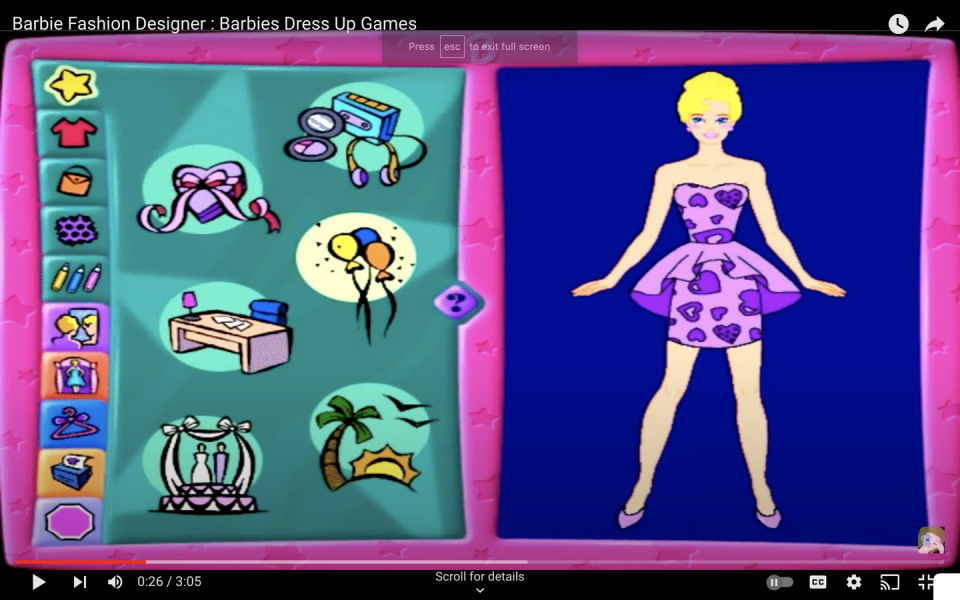A Generation of Gamers Started Out Playing Barbie Fashion Designer

- Oops!Something went wrong.Please try again later.
- Oops!Something went wrong.Please try again later.
The monologue given by the presenter of the 2019 Writers Guild Award for Videogame Writing was so incredibly cringeworthy, it’s lodged in my skull for life, and I wasn’t even there. Buried inside a monologue about gamers not having sex (Dr. NerdLove would like a word), the presenter described what came to mind when he thought of gamers: “Grown men … in their underwear in their basement.”
He had part of it right: The average age of a gamer is 35, and according to a survey published in 2020, 15 percent of gamers are older than 55. Video game development in the United States kicked off in earnest in the 1970s, so we have a generation of parents and grandparents who grew up with video games and have passed them on to their kids. So, “grown,” sure. The rest of what the presenter had to say bore little resemblance to reality.
It would be easy to call jokes (using the term loosely) like his outdated, but it would be hard to find a date in which they were accurate. How do I know that? Because Barbie Fashion Designer outsold Doom. Some of you are rushing to caveat that statement, but in its first two months on the shelves, Barbie Fashion Designer sold more than 500,000 copies, a runaway success in 1996. Neither Doom, nor Quake, considered titans of video games, sold as many copies in the same amount of time, so by this crucial post-launch metric, Barbie pulls ahead. What this tell us is that Barbie Fashion Designer appealed to someone—a lot of someones. It was a game marketed to little girls in 1996, and it was so successful it launched a flurry of games designed with girls in mind.
Before I keep going, I want to make something clear: Gender binaries tell us very little about real people, including gamers. Little girls played Doom; little boys played Barbie Fashion Designer. Nonbinary gamers don’t fall into either category, but have probably played either or both. What I’m talking about here is target audiences. Who did the developers and marketers have in mind when creating a game? Who did they expect to play it? Did their ads show little boys or girls playing it? Who did they invite into the gaming space? Pop culture, even now (looking at you, Stranger Things), tells us over and over that video games are the realm of boys, and only a few girls—the ones who are different, “not like other girls”—play games at all. But the evidence tells us another story.

Barbie Fashion Designer had a simple premise that was easy to pick up for first-time gamers. You dressed a 2D Barbie in skirts, tops, pants, whatever suited your fancy, clicking and dragging outfits onto her. Some of the designs were pre-crafted; others were blank slates, skirts, or tops the player could fill in with their own colors and doodles using in-game markers. But the game added a multimedia component: After you designed Barbie’s outfits, you could print them out onto fabric-backed paper that came with the game. These printed designs could then be used to dress a real-life Barbie doll. That premise worked: Barbie Fashion Designer earned more than $14 million in sales by the end of 1996.
Mattel and Barbie were not the first to consider making software that appealed to little girls. Early games made by women didn’t target one gender or another, but simply focused on kids. One of the first video games ever created was written by a woman, Mabel Addis Mergardt, between 1963 and ’67, and its job was to teach children history and simple economics. Joyce Weisbecker was one of the first game designers, releasing several games between 1976 and ’77. Game designers like Brenda Laurel, Sheri Graner Ray, and Megan Gaiser asked the question loudly and often in the 1980s and ’90s: Where were the games designed and marketed to little girls? They were met with everything from shrugs to mockery until the Games for Girls movement.
The movement began as an informal one, an initiative by toy, game, and software companies in the 1990s to launch a surge of products marketed to little girls. It was called the Games for Girls movement later by developers and scholars alike. The goal was twofold: to sell to an untapped audience and to encourage little girls to take an interest in STEM fields.
For some companies, like Mattel, this meant applying what was already popular in their toys to video games. Barbie Fashion Designer took the sparkly pink boxes and dress-up play of Barbie dolls and made it digital. For other game designers, like Laurel, marketing games to little girls meant figuring out what they liked. After two years of research and interviews with more than a thousand children, Laurel determined that, generally speaking, little girls liked games that featured complex social interactions, relatable characters, and gameplay that asked them what they thought and felt.
The Games for Girls movement quickly but informally split into two: pink games and purple games. Barbie titles fell into the former category; games made by Laurel’s studio, Purple Moon, and the Nancy Drew series created by HeR Interactive fell into the latter. The split was about more than box colors or gameplay types; it was philosophical. Laurel said Barbie Fashion Designer “perpetuated a version of femininity that was fundamentally lame.” Gaiser, former CEO of HeR Interactive, described her team’s reaction to the pink Mattel boxes as “Ugh, really?” This reflected a cultural argument that dominated the 1990s: what was feminist versus what was feminine.
Looking back on the Games for Girls movement nearly 30 years later, feelings about the games it launched and the movement itself are mixed. On the one hand, you have articles like Patricia Hernandez’s essay for Kotaku, “She Tried to Make Good Video Games for Girls, Whatever That Meant,” and books like Beyond Barbie & Mortal Kombat: New Perspectives on Gender and Gaming. These argue that both gender and the expression of “play” are far more complicated than “girl games” versus “boy games.” What children are allowed or encouraged to do, what they model from other children in their homes and lives, and their own tastes can and do vary widely. Gender is not simply pink or blue, and neither are the games children of all genders play.
On the other hand, you have sales numbers and nostalgia. Barbie Fashion Designer was the first “game for girls” that was also a best seller. Said Joyce Slaton of GameSpot, “Mattel’s successful innovation [was] placing Barbie Fashion Designer on toy aisles rather than in the boy-dominated software section in toy stores.” When I posted a tweet about Barbie Fashion Designer, I was flooded with replies, many of them fond memories from adults who had played the game as little girls. They remembered spending hours in front of the computer, printing out their designs and carefully budgeting which were worth the all-too-precious fabric-backed paper. For some, it was the first time they spent long periods in front of a computer. By playing with Barbie, they became comfortable with save files, keyboards, and inkjet printers.
“The people who grew up playing these games are adults now—there’s a lot of nostalgia for them,” Illinois Tech professor Carly Kocurek said in an article about her research into the Games for Girls movement. “We’re starting to see that a lot of the folks that were designers and influential during the Games for Girls movement have become leaders. We have a radically different landscape for games now, so ‘Games for Girls’ sounds almost antiquated—because of course people are making games for many different audiences—but that wasn’t always the case.”
However, there’s another philosophical caveat that gamers and game developers alike sometimes lob at statistics like these, and that is: Barbie Fashion Designer, and games like it, aren’t “real” games. Barbie Fashion Designer, walking simulators (a genre in which you walk through a designed space, often interacting with objects and listening to monologues), and mobile games all tend to get lumped into this criticism. These games—particularly mobile games—have a wider and more diverse player base than PC or console games. The argument about what constitutes a real video game, at its core, amounts to little more than gatekeeping. Barbie Fashion Designer is as much of a video game as Doom; they simply have different gameplay styles and player goals. Both are digital, control images on a screen, and build in rewards. One is not morally or mechanically superior to the other, and the fact they are both successful tells us a lot about gamers. Namely, that hacks making jokes about men in their underwear don’t know what they’re talking about—gamers are so much more than that.
You Might Also Like

